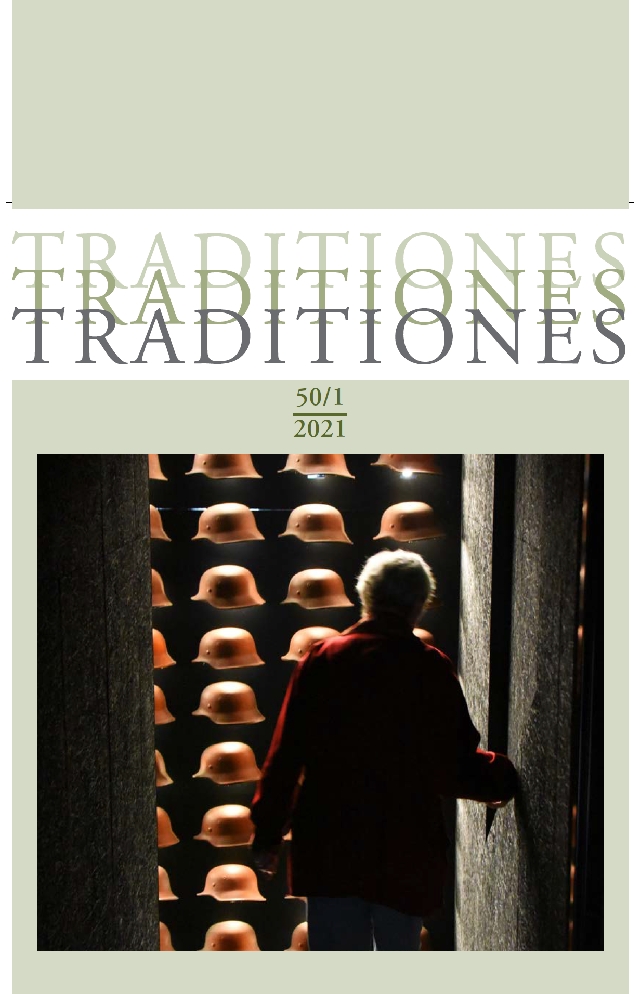Spremembe v nesnovni dediščini na Slovaškem: Primer fujare
DOI:
https://doi.org/10.3986/Traditio2021500109Ključne besede:
dediščina fujare, podeželje, mesto, trajnost, transformacija, inventar, Reprezentativni seznam Slovaške nesnovne kulturne dediščine, SlovaškaPovzetek
Cilj raziskave je pokazati na okolje in funkcije fujare (ljudska pastirska piščal) – prvega elementa nesnovne kulturne dediščine, ki je vpisan na Reprezentativni seznam nesnovne kulturne dediščine (NKD) na Slovaškem. Članek je pozoren na slovaško zakonodajo o varovanju NKD in na terminologijo, ki z vidikov državne zaščite kulturne dediščine in znanosti postaja vse bolj poenotena. Spremembe v naravnem okolju so prav tako vplivale na funkcije fujare in igranja nanjo. Glede na spremembe in razširjanje kulture iz podeželskega v mestno okolje sta avtorja pozorna na nove načine učenja igranja na fujaro in na deleže vertikalnih, horizontalnih in posrednih načinov prenašanja.
Prenosi
Literatura
Altman, Irwin. 1973. Some Perspectives on the Study of Man-Environment Phenomena. Representative Research in Social Psychology, EDRA 4: Fourth International EDRA Conference: 98–113.
Assman, Jan. 2001. Kultura a paměť: Písmo, vzpomínky a politická identita v rozvinutých kulturách starověku. Praha: Prostor.
Benža, Mojmír, et al. 2010. Metodologické zošity na podporu výskumu, spracovania a prezentovania tradičnej kultúry. In Inventarizácia tradičnej ľudovej kultúry, ed. Vladimír Kyseľ. Bratislava: Koordinačné centrum tradičnej ľudovej kultúry.
Bitušíková, Alexandra. 2000. Nové prístupy k výskumu kultúrneho dedičstva. Etnologické rozpravy 22: 7–14.
Brubaker, Rogers, and Frederick Cooper. 2000. Beyond “Identity”. Theory and Society 29. http://works.bepress.com/wrb/2/.
Brumann, Christoph. 2014. Heritage Agnosticism: A Third Path for the Study of Cultural Heritage. Social Anthropology 22 (3): 173–88. DOI: https://doi.org/10.1111/1469-8676.12068.
Bushman, Dan. 2000. Expresivism as “Vernacular Theories.” In Reforming College Composition: Writing the Wrongs, eds. Ray Wallace, Alan jackson and Susan Wallace, 27–29. Westport: Greenwood Press.
Danglová, Oľga. 2006. Lokálne kontexty identity. In Svet mnohých „MY a ONI“, eds. Vladimír Krivý and Oľga Danglová, 105–185. Bratislava: Centrum excelentnosti SAV, 2006.
Danglová, Oľga. 2011. Vidiecke sídlo ako priestor identity: Výber z prípadových štúdií štyroch slovenských obcí. Národopisní informace 2: 93–102.
Doubek, David, Markéta Levínská, and Dana Bittnerová. 2013. Socializace dítěte ve vyloučené lokalitě: schéma děti si dělají, co chtějí. Lidé města 15/2. http://lidemesta.cz/index.php?id=895.
Elschek, Oskár. 1979. Melographische Interpretationscharakteristika von Flötenmusik. Studia Instrumentorum musiace popularis 6: 43–58. Stockholm.
Elschek, Oskár. 1983. Die Volksmusikinstrumente der Tschechoslowakei. Teil 2: Die Slowakei, eds. Ernst Emsheimer and Erich Stockmann. In Handbuch der europäischen Volksmusikinstrumente: Serie 1, Band 2, 201 ff. Leipzig: Deutscher Verlag für Musik.
Elschek, Oskár. 2009. Fujara ako výtvarné dielo. Bratislava: Dolis.
Garaj, Bernard. 2006. The Fujara – A Symbol of Slovak Folk Music and New Ways of Its Usage. Proceedings from the 16th International Meeting, ed. ICTM Study Group on Folk Musical Instruments. = Tautosakos darbai 12 (16).
Garaj, Bernard. 2007. K zápisu fujary na Zoznam majstrovksých diel ústneho a nehmotného dedičstva UNESCO. In Tradičná a ľudová kultúra v dokumentoch UNESCO, ed. Juraj Hamar, 101–108. Bratislava: Slovenské centrum pre tradičnú kultúru.
Hamar, Juraj. 2007. Odporúčania na ochranu tradičnej kultúry a folklóru. In Tradičná a ľudová kultúra v dokumentoch UNESCO, ed. Juraj Hamar, 9–16. Bratislava: Slovenské centrum pre tradičnú kultúru.
Hamar, Juraj. 2013. The Convention for the Safeguarding of the Intangible Culture Heritage: In the Mirror of Implementation Discourse in Slovakia. Slovak Ethnology 16 (5): 497–506.
Henrich, Joseph, and Francisco J. Gil-White. 2001. The Evolution of Prestige: Freely Conferred Deference as a Mechanism for Enhancing the Benefits of Cultural Transmission. Evolution and Human Behavior 22 (3): 165–196. DOI: https://doi.org/10.1016/S1090-5138(00)00071-4.
Leščák, Milan. 2006. Úvod do folkloristiky. Bratislava: Národné osvetové centrum.
Lubej, Emil. 1995. Akustische Analysen slowakischer Aeorophone: Fujara und Píšťala. Studia instrumentorum musicae popularis 11: 122–126.
Luther, Daniel. 2012. Slovak State Traditional Dance Company. http://www.ludovakultura.sk/index.php?id=5113.
Luther, Daniel. 2015. Nehmotné kultúrne dedičstvo z pohľadu etnológie. Etnologické rozpravy 22 (1): 15–23.
Ngo, Hieu Van. 2008. A Critical Examination of Acculturation Theories. Critical Social Work 9 (1). DOI: https://doi.org/10.22329/csw.v9i1.5762.
Nikischer, Richard. 2013. Formovanie teritoriálnej identity Čechov a Slovákov. In Medzinárodný vedecký časopis Mladá veda/Young Science, 4–21. Prešov: Vydavateľstvo UNIVERSUM-EU.
Smith, Laurajane, and Natsuko Akagawa. 2009. Intangible Heritage. London: Taylor and Francis Group.
Vansina, Jan. 2009. Oral Tradition: A Study in Historical Methodology. London: Aldine Transaction.
Prenosi
Objavljeno
Kako citirati
Številka
Rubrike
Licenca

To delo je licencirano pod Creative Commons Priznanje avtorstva-Nekomercialno-Brez predelav 4.0 mednarodno licenco.
Avtorji jamčijo, da je delo njihova avtorska stvaritev, da v njem niso kršene avtorske pravice tretjih oseb ali kake druge pravice. V primeru zahtevkov tretjih oseb se avtorji zavezujejo, da bodo varovali interese založnika ter da bodo povrnili morebitno škodo.
Podrobneje v rubriki: Prispevki






